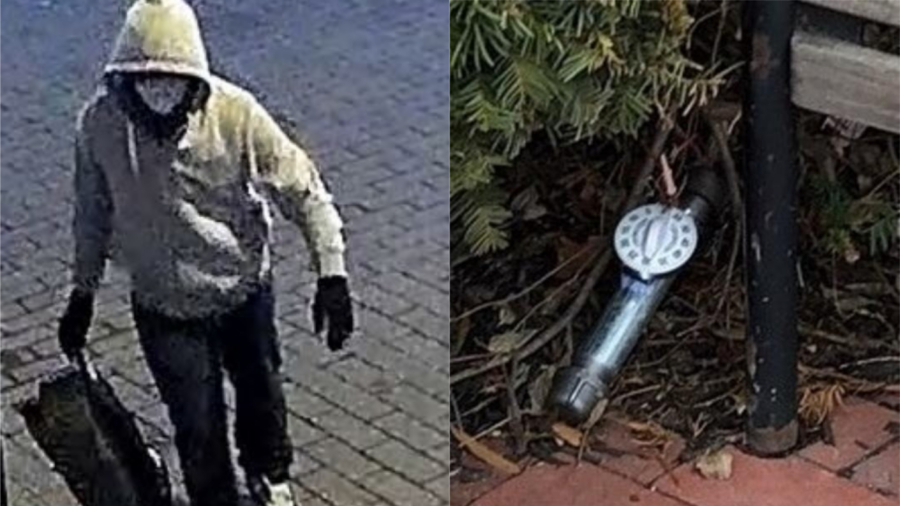The Federal Bureau of Investigation (FBI) on Jan. 4 announced that the reward for information about the suspect who allegedly planted pipe bombs near the headquarters of the Republican National Committee (RNC) and the Democratic National Committee (DNC) in Washington, D.C., has increased from $100,000 to $500,000.
The incident occurred two years ago. The suspect is alleged to have planted the pipe bombs on Jan. 5, 2021, between about 7:30 p.m. and 8:30 p.m. local time—the night before Jan. 6, when people breached the Capitol Building and briefly interrupted a joint session of Congress to certify the 2020 election.
One bomb was placed in an alley behind RNC headquarters, located at 310 First Street Southeast, while the other was placed near the DNC headquarters, located at 430 South Capitol Street Southeast #3.
“Two years into the investigation, identifying the perpetrator of this attempted attack remains a priority” for the FBI, the Bureau of Alcohol, Tobacco, Firearms, and Explosives (ATF), the D.C. Metropolitan Police Department, according to an announcement on the FBI’s website.
Although the bombs did not detonate, the announcement said it is “important to remember” the suspect was just blocks from the U.S. Capitol “with viable pipe bombs that could have seriously injured or killed innocent bystanders.”
“Moreover, the suspect may still pose a danger to the public or themselves.”
Investigators are urging the American public to “take a fresh look” at the Seeking Information website, which features images and video of the suspect, their backpack, shoes, explosive devices, as well as a map of the route they walked the night the pipe bombs were allegedly planted.
“We note that many of the components used to build the pipe bombs were widely available for purchase in-store and online,” the announcement reads. “Some of the components used to construct these devices include 1×8-inch threaded galvanized pipes, end caps, kitchen timers, wires, metal clips, and homemade black powder.”
Investigators said they have carried out about 1,000 interviews, visited more than 1,200 residences and businesses, collected more than 39,000 video files, and looked into nearly 500 tips. They said that additional details can’t be released to “maintain the integrity of the investigation.”
Those who want to provide tips are asked to provide as many details as possible about potential individuals of interest, including biographic information, contact information, demographic information, what kind of access they had to pipe bomb components, and how close they were to Washington, D.C., in early January 2021.
David Sundberg, assistant director in charge of the FBI Washington Field Office, said in a statement that a dedicated team of FBI agents, analysts, and law enforcement partners have been “tirelessly reviewing evidence and digital media” related to the probe into the suspect for two years.
“We remain grateful to the American people, who have provided invaluable tips that have helped us advance the investigation,” he said. “With the significantly increased reward, we urge those who may have previously hesitated to contact us—or who may not have realized they had important information—to review the information on our website and come forward with anything relevant. Despite the unprecedented volume of data review involved in this case, the FBI and our partners continue to work relentlessly to bring the perpetrator of these dangerous attempted attacks to justice.”
Steve D’Antuono, the FBI’s lead agent in Washington, had told CBS News in January 2022 that the alleged pipe bombs were disabled before they could explode. The suspect “was covered from head to toe” and was wearing glasses, a mask, gloves, and a hooded sweatshirt, such that officials can’t tell whether the suspect is male or female, D’Antuono told the outlet.
The FBI in March 2021 released the first video footage of the suspect. Prior to that, the agency had released still images. In September 2021, the FBI released more video footage and additional information about the incident, with the footage purporting to show the suspect sitting on a bench near the DNC headquarters near where the device was placed, the FBI said.
Ray Epps Warned FBI of Bomb Attack
The Epoch Times reported in August 2022 that a man named Ray Epps had told the FBI in March 2021 that he had expected a bomb attack near the U.S. Capitol on Jan. 6, 2021, and that he brought a first-aid kit in his backpack in case of an attack.
“I was afraid they were going to set off an explosion on one of the side streets,” Epps said, according to a recording of the interview obtained by The Epoch Times. “So we tried to stay in the middle, tried to get there early, tried to stay away from the sides. And if something like that happened, I had a first-aid kit. I could help out.”
At another point of the interview, Epps said: “I thought something would happen in D.C. I thought there might be, what do they call them, EOD, something like that?”
Epps might have been referring to an improvised explosive device (IED), which is a homemade bomb that was a favorite weapon of insurgents in Afghanistan during the long U.S. war there. In military parlance, an EOD refers to an explosive ordnance disposal specialist—someone who defuses and destroys explosives.
An agent asked for clarification: “Oh, you mean like a terrorist act?”
“Right, like a terrorist act,” Epps said.
The agents didn’t press Epps on what led him to believe there would be an explosion, nor did they ask about the two alleged pipe bombs found outside the Republican and Democratic party headquarters, each just blocks from the Capitol. The Republican National Committee pipe bomb was placed near the corner of the Capitol Hill Club facing a side street, similar to the description Epps offered.
Joseph M. Hanneman and Jack Phillips contributed to this report.
From The Epoch Times

